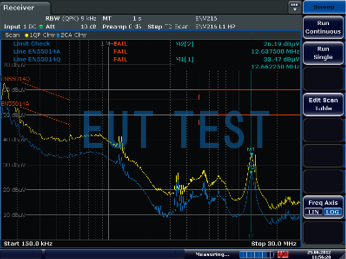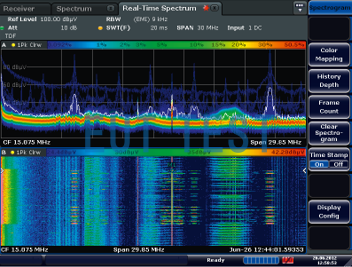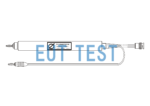Product Description:
R&S ESR is an EMI test receiver, including ESR3, ESR7, ESR26, frequency range between 10 Hz-26.5 GHz and comply with CISPR 16-1-1 standard. ESR serial receiver can be used as an EMI receiver or as a spectrum analyzer, which can fully satisfy the test requirements of R & D engineers.
Ltd. is the agent of R&S company to provide all test products and test accessories.
Feature Description:
The receiver can measure electromagnetic interference by means of a conventional stepped frequency sweep or by means of an FFT-based time-domain sweep at very high speeds. At the same time, the R&S®ESR also serves as a powerful, full-featured signal and spectrum analyzer for laboratory applications. With real-time spectrum analysis and a wide range of diagnostic tools, the test receiver can be used to analyze interference signals and their history in detail. The R&S®ESR is easy to operate in all modes thanks to clearly structured menus and an intuitive touch screen.
R&S ESR Integrated EMI Receiver and Spectrum Analyzer Test Modes:

R&S ESR Receiver Mode Test Chart

R&S ESR Real-Time Spectrum Analyzer Mode Test Chart
Product Features:
- Compliant with CISPR 16-1-1 version 3.1
- Preselection with integrated 20 dB preamplifier
- The resolution bandwidth is CISPR-compliant and optionally available in decimal steps from 10 Hz to 1 MHz (MIL STD-461,DO-160)
- Ultra-fast time-domain scanning (option) or conventional stepped frequency scanning
- Real-time spectrum analysis across up to 40 MHz for detailed investigation of interference (option)
- High-resolution time-domain display (50 μs)
- Automated test programs
- IF analysis (option)
- Features and Benefits
- Standards-compliant interference measurements
- Certified Measurement
- Performs standards-compliant EMI measurements in spectrum analyzer mode
- Ultra-fast measurements via FFT-based time-domain scanning (option)
- Extremely fast measurements due to hardware-based FFT calculation
- Real-time measurement of conducted interference level by synchronized quasi-peak and average weighting
- Real-time spectrum analysis for detailed investigation of interference (option)
- Seamless display of the spectrum in the time domain using waterfall plots
- Utilizes afterglow patterns (spectral histograms) for clear identification of pulsed and continuous interference
- Frequency template triggering for accurate and reliable detection of irregularly occurring spectral events
- Powerful measurement and analysis functions in the frequency and time domains
- Automated test sequences covering preview measurements, data simplification, and final measurements
- IF analysis function that displays the spectrum around the interfering signal (option)
- Time Domain Display - Integrated Oscilloscope Function
- Synchronized display of up to six traces and four bars
- Preset antenna factors (conversion factors) and user-created sets of conversion factors
- Commercially compliant EMI limit line library with quick editor
- utilization R&S®EMC32 Measurement Softwareand R&S®ES-SCAN EMI software for remote control measurements and automated EMI test programs.
- Extensive analytical capabilities for general laboratory applications
- Trace generator for scalar network analysis (optional)
- Easy to operate and display information that is easy to understand
- Touch screen based user interface with undo/redo functionality
- Visualization Scanner
- Integrated online help
- Save results and instrument settings to internal or external media
- Removable hard disk drive (HDD) to protect the confidentiality of test data
- Remote control via GPIB or LAN
- Drivers for LabView, LabWindows/CVI, VXI Plug & Play
- Firmware updates - keeping pace with new developments
- Compact and rugged - also suitable for mobile applications
- DC power supply for field applications, with optional external battery pack and reinforced housing
- Solid State Drives (SSDs) with high vibration and shock load resistance
- compact design
- Standards-compliant interference measurements
ESR Technical Specifications:
<<<<提醒:左右滑动表格>>>>| frequency | ||
| Frequency range | R&S®ESR3 | 9 kHz to 3.6 GHz |
| R&S®ESR3 (with R&S)®(ESR-B29 option) | 10 Hz to 3.6 GHz | |
| R&S®ESR7 | 9 kHz to 7 GHz | |
| R&S®ESR7 (with R&S)®(ESR-B29 option) | 10 Hz to 7 GHz | |
| R&S®ESR26 | 9 kHz to 26.5 GHz | |
| R&S®ESR26 (with R&S)®(ESR-B29 option) | 10 Hz to 26.5 GHz | |
| power level (elec.) | ||
| Maximum RF level (continuous wave) | RF attenuation ≥ 10 dB; Shutting down the RF preamplifier euttest RF attenuation ≥ 10 dB; Enable RF preamplifier euttest | 30 dBm (= 1 W) 23 dBm (= 0.2 W) |
| Maximum pulse voltage | RF attenuation ≥ 10 dB Input 1 Input 2 | 150 V 450 V |
| Maximum pulse energy | RF attenuation ≥ 10 dB; 10 μs Input 1 Input 2 | 1 mWs 20 mWs |
| 1 dB compression | RF attenuation 0 dB; RF preamplifier off and preselected | +3 dBm, nominal |
| agent | www.euttest.com | |
| IF and resolution bandwidth | ||
| Analyzer mode (≥ 10 Hz) and receiver mode | 10 Hz to 10 MHz (-3 dB) in 1/2/3/5/10 steps | |
| Analyzer and receiver mode | 200 Hz, 9 kHz, 120 kHz (-6 dB), 1 MHz (pulse bandwidth) | |
| with R&S®ESR-B29 option (in analyzer and receiver modes) | Increase 10 Hz to 100 kHz (-6 dB), in decimal steps | |
| short-listing | Can be turned off in analyzer mode | 16 fixed filters |
| Preamplifier | Can be turned on/off | 1 kHz to 26.5 GHz |
| measuring time | Analyzer mode (scan time) | Frequency span = 0 Hz: 1 μs to 16 000 s Frequency span ≥ 10 Hz (sweep): 1 ms to 16 000 s Frequency span ≥ 10 Hz (FFT): 7 μs to 16 000 s |
| Receiver mode (stepped frequency sweep) Receiver mode (time domain scanning) | 50 μs to 100 s (depending on frequency) 50 μs to 100 s (depending on frequency subrange) | |
| frequency step | Receiver mode (stepped frequency sweep) Receiver mode (time domain scanning) | Minimum 1 Hz 0.25 × IF bandwidth |
| oscillograph | receiver mode | Maximum peak value, minimum peak value, quasi-peak value, root mean square value, mean value, euttest Average value with measurement time constant (CISPR average), RMS average (CISPR-RMS) |
| Display Average Noise Level (DANL) | Receiver Mode, Nominal, Average Detector (AV), RF Attenuation 0 dB, Terminated 50 Ω | |
| Turn off the preamplifier | ||
| 30 MHz < f < 1 GHz, bandwidth 120 kHz | < 8 dBμV | |
| 1 GHz < f < 3.6 GHz, bandwidth 1 MHz | < 20 dBμV | |
| 3.6 GHz < f < 26.5 GHz, bandwidth 1 MHz | < 26 dBμV | |
| agent | euttest | |
| Turn on the preamplifier | ||
| 30 MHz < f < 1 GHz, bandwidth 120 kHz | < -3 dBμV | |
| 1 GHz < f < 3.6 GHz, bandwidth 1 MHz | < 9 dBμV | |
| 3.6 GHz < f < 26.5 GHz, bandwidth 1 MHz | < 13 dBμV | |
| Number of scanning (trace) points | ||
| Analyzer mode (standard) | 101 to 32 001 | |
| Analyzer Mode (EMI) | 101 to 200 001 | |
| receiver mode | Maximum 4 000 000 | |
| Real-time analyzer (option) | 801 | |
| Overall measurement uncertainty | Continuous Wave Signal, Level 0 dB to -70 dB (below reference level), S/N > 20 dB, Auto Scan Time, RF Attenuation 10 dB, 20 dB, 30 dB, 40 dB, Preamplifier On, Span/RBW 95 % Confidence, +20°C to +30°C | |
| 9 kHz ≤ f < 3.6 GHz | 0.47 dB | |
| 3.6 GHz ≤ f ≤ 7 GHz | 0.59 dB | |
| 7 GHz ≤ f ≤ 13.6 GHz | 1.01 dB | |
| 13.6 GHz ≤ f ≤ 26.5 GHz | 1.34 dB | |








